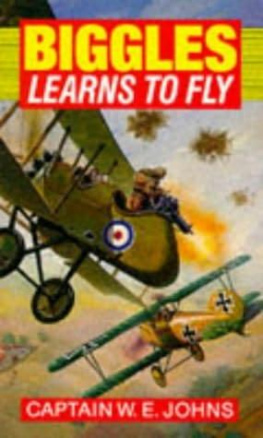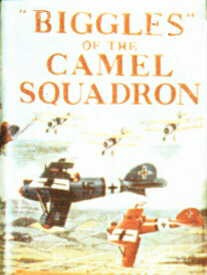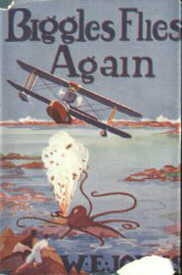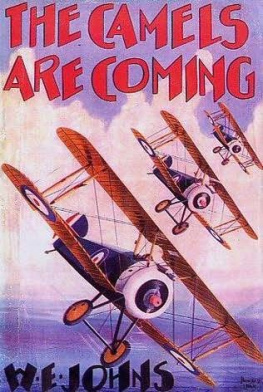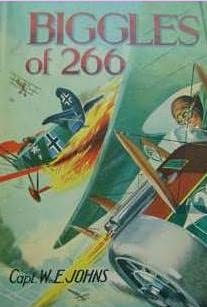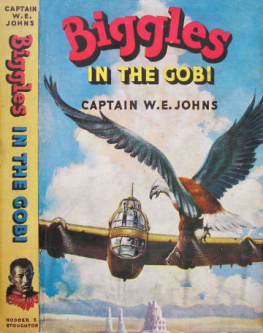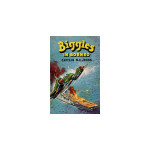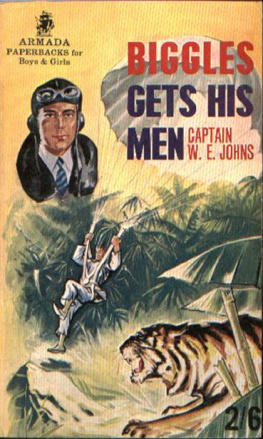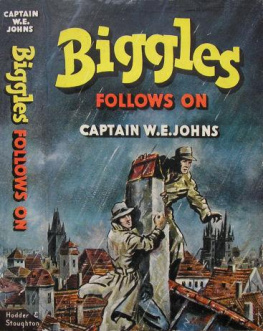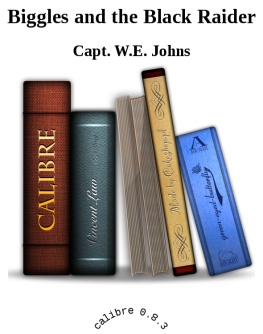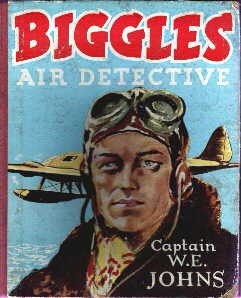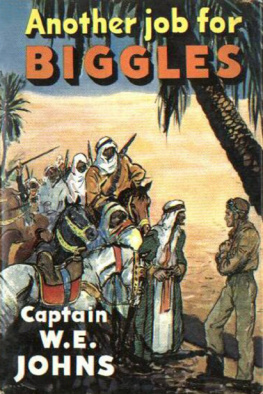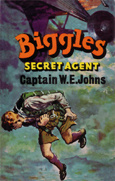W. E. Johns - Biggles Learns to Fly
Here you can read online W. E. Johns - Biggles Learns to Fly full text of the book (entire story) in english for free. Download pdf and epub, get meaning, cover and reviews about this ebook. year: 1992, publisher: Red Fox, genre: Detective and thriller. Description of the work, (preface) as well as reviews are available. Best literature library LitArk.com created for fans of good reading and offers a wide selection of genres:
Romance novel
Science fiction
Adventure
Detective
Science
History
Home and family
Prose
Art
Politics
Computer
Non-fiction
Religion
Business
Children
Humor
Choose a favorite category and find really read worthwhile books. Enjoy immersion in the world of imagination, feel the emotions of the characters or learn something new for yourself, make an fascinating discovery.
- Book:Biggles Learns to Fly
- Author:
- Publisher:Red Fox
- Genre:
- Year:1992
- Rating:4 / 5
- Favourites:Add to favourites
- Your mark:
- 80
- 1
- 2
- 3
- 4
- 5
Biggles Learns to Fly: summary, description and annotation
We offer to read an annotation, description, summary or preface (depends on what the author of the book "Biggles Learns to Fly" wrote himself). If you haven't found the necessary information about the book — write in the comments, we will try to find it.
Biggles Learns to Fly — read online for free the complete book (whole text) full work
Below is the text of the book, divided by pages. System saving the place of the last page read, allows you to conveniently read the book "Biggles Learns to Fly" online for free, without having to search again every time where you left off. Put a bookmark, and you can go to the page where you finished reading at any time.
Font size:
Interval:
Bookmark:
Author's Note
The printing of this book is the answer to those who have asked when and where Biggles learned to fly. It was written many years ago, while the events were fresh in the author's mind, long before there was any talk of Hitler and a Second World War. The sons of some of the boys who read it then now fly jets. Time marches onand in aviation it has marched very fast indeed. But this was the beginning, and the beginning of Biggles. To readers of the modern Biggles books these early adventures may seem strange, both in the terms used and in the style of conversation. But Biggles was very young then. So was the Air Service. In fact, there was no air service. Fighting planes were flown by officers seconded from the Army (the R.F.C.) and the Navy (Royal Naval Air Service). When Biggles (and the author) learned to fly, aeroplanes and equipment, by modern standards, were primitive. Combat tactics, as they are understood today, were unknown. Every pilot had his own method and, if he lived long enough, picked up a few tricks from the old hands. Once in the air he could more or less do as he pleased, for he was out of touch with the ground except by simple visual signals.
Communication between aircraft, or between pilot and gunner, was also by hand signals. Crossed fingers meant an enemy aircraft. First finger and thumb in the form of a circle meant British aircraft. Thumbs up meant all was well. Thumbs down
well, not so good. One also signalled the approach of enemy aircraft by rocking one's wings.
As the reader may guess, the writer's own experiences were much the same as those described herein. A few flights, and off you went solo. A few hours solo, and off you went to war, to take your luck. Casualties, of course, were grim; but all the same, happygo-lucky were those days that have now become history. The mystery is that anyone survived, for apart from the risks of battle, structural failure was common, and there were no parachutes. On the other hand, the machines being slow, and made of wood, wire and fabric, one had a better chance in a crash than in the modern high-performance fighter.
The word 'Hun', as used in this book, was the common generic term for anything belonging to the enemy. It was used in a familiar sense, rather than derogatory. Witness the fact that in the R.F.C. a hun was also a pupil at a flying training school.
First Time Up!
One fine late September morning in the war-stricken year of 1916, a young officer, in the distinctive uniform of the Royal Flying Corps, appeared in the doorway of one of the long, low, narrow wooden huts which, mushroom-like, had sprung up all over England during the previous eighteen months. He paused for a moment to regard a great open expanse that stretched away as far as he could see before him in the thin autumn mist that made everything outside a radius of a few hundred yards seem shadowy and vague. There was little about him to distinguish him from thousands of others in whose ears the call to arms had not sounded in vain, and who were doing precisely the same thing in various parts of the country. His uniform was still free from the marks of war that would eventually stain it. His Sam Browne belt still squeaked slightly when he moved, like a pair of new boots.
There was nothing remarkable, or even martial, about his physique; on the contrary, he was slim, rather below average height, and delicate-looking. A wisp of fair hair protruded from one side of his rakishly tilted R.F.C. cap; his eyes, now sparkling with pleasurable anticipation, were what is usually called hazel. His features were finely cut, but the squareness of his chin and the firm line of his mouth revealed a certain doggedness, a tenacity of purpose, that denied any suggestion of weakness. Only his hands were small and white, and might have been those of a girl.
His youthfulness was apparent. He might have reached the eighteen years shown on his papers, but his birth certificate, had he produced it at the recruiting office, would have revealed that he would not attain that age for another eleven months. Like many others who had left school to plunge straight into the war, he had conveniently 'lost' his birth certificate when applying for enlistment, nearly three months previously. A heavy, hair-lined leather coat, which looked large enough for a man twice his size, hung stiffly over his left arm. In his right hand he held a flying-helmet, also of leather but lined with fur, a pair of huge gauntlets, with coarse, yellowish hair on the backs, and a pair of goggles.
He started as the silence was shattered by a reverbererating roar which rose to a mighty crescendo and then died away to a low splutter. The sound, which he knew was the roar of an aero-engine, although he had never been so close to one before, came from a row of giant structures that loomed dimly through the now-dispersing mist, along one side of the bleak expanse upon which he gazed with eager anticipation. There was little enough to see, yet he had visualized that flat area of sandy soil, set with short, coarse grass, a thousand times during the past two months while he had been at the 'ground' school. It was an aerodrome, or, to be more precise, the aerodrome of No. 17 Flying Training School, which was situated near the village of Settling, in Norfolk. The great, darkly looming buildings were the hangars that housed the extraordinary collection of hastily built aeroplanes which at this period of the first Great War* were used to teach pupils the art of flying.
A faint smell was borne to his nostrils, a curious aroma that brought a slight flush to his cheeks. It was one common to all aerodromes, a mingling of petrol, oil, dope**, and burnt gases, and which, once experienced, was never forgotten. Figures, all carrying flying-kit, began to emerge from other huts and hurry towards the hangars, where strange-looking vehicles were now being wheeled out on to a strip of concrete that shone whitely along the front of the hangars for their entire length. After a last appraising glance around, the new officer set off at a brisk pace in their direction. A chilly breeze had sprung up; it swept aside the curtain of mist and exposed the white orb of the sun, low in the sky, for it was still very early. Yet it was daylight, and no daylight was wasted at flying schools. during the Great War. He reached the nearest hangar, and then stopped, eyes devouring an extraordinary structure of wood, wire, and canvas that stood in his path. A propeller, set behind two exposed seats, revolved slowly. Beside it stood a tall, thin man in flying-kit; his leather flying-coat, which was filthy beyond description with oil stains, flapped open, exposing an equally dirty tunic, on the breast of which a device in the form of a small pair of wings could just be seen. Under them was a
* The First World War 19l4I8. Principal contenders, the Allies: Britain, France, Russia, Italy, Serbia, Belgium, Japan (1910, Romania (1916), USA (1917). Against the Central Powers: Germany, Austria-Hungary, Turkey and Bulgaria (1910.
** Liquid similar to varnish, applied to the fabric surfaces to stiffen and weatherproof them.
tiny strip of the violet-and-white ribbon of the Military Cross. To a fully fledged pilot the figure would have been commonplace enough, but the young newcomer regarded him with an awe that amounted almost to worship. He knew that the tall, thin man could fly; not only could he fly, but he had fought other aeroplanes in the sky, as the decoration on his breast proved. At that moment, however, he seemed merely bored, for he yawned mightily as he stared at the aeroplane with no sign of interest. Then, turning suddenly, he saw the newcomer watching him.
`You one of the fellows on the new course?' he asked shortly. reryes, sir,' was the startled reply.
ver been in the air?'
Next pageFont size:
Interval:
Bookmark:
Similar books «Biggles Learns to Fly»
Look at similar books to Biggles Learns to Fly. We have selected literature similar in name and meaning in the hope of providing readers with more options to find new, interesting, not yet read works.
Discussion, reviews of the book Biggles Learns to Fly and just readers' own opinions. Leave your comments, write what you think about the work, its meaning or the main characters. Specify what exactly you liked and what you didn't like, and why you think so.

